|
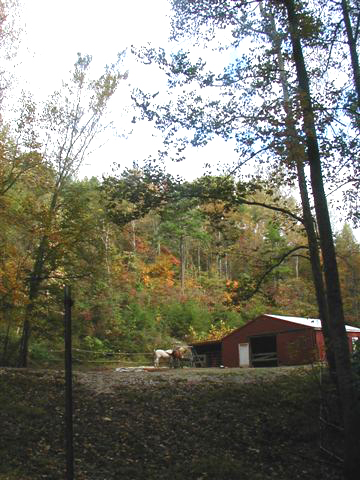
Autumn's arrival in Appalachia. Sunset
Ridge, Stanton, Kentucky.
(*photo by
Marge Para)
November 1, 2007 Can We Be Saints?
On All Saints Day we ask a searching question as we look out
over the multitudes who are moving towards or have settled down in
their heavenly home. Their numbers are large, thank God -- but
will they include us? That is what we ask, knowing that the
suffering, starving, hungry folks in all parts of the world whose
lives are being cut so short must be in the multitude making their
way to the Light. The vague question of the title of this
reflection has behind it the cynical response of investigative
media persons who can cut down anyone. They wince in horror that
Mother Theresa had a long dry period in her own spiritual journey,
as though a sweet time here ensures a sweet bye and bye.
Maybe we can comb the Scriptures and the lives of great saints and
find helpful signs that will give us added hope in this troubled
world in which we find ourselves:
* Accepting suffering -- Active and passive events go to make
us an imitation of Christ carrying his cross. Christ promised us
this suffering as a way to sainthood whether that be unexpected
physical discomfort and shortened life or active effort that we
must undertake in helping others. So we are called to accept or
take up our cross joyfully and with a sense of trust in the Lord.
* Being watchful -- When health is still good we seek to exert
ourselves as actively performing the mission given to us to do, and
doing so cheerfully and with wholeness of heart. The time is short
and so we have to make the best of our days.
* Approaching all hopefully -- We resolve to overcome any form
of cynicism, excess criticism and denunciation of others by seeing
good in those we meet, and have a hope that things will improve for
all. Even when we choose to be apocalyptic, we strive to rally
others to becoming positive in their own approaches to life.
* Being honest before God -- We speak to God in the simplicity
of prayer like the "publican" in the parable. The Lord knows our
imperfect condition, and that in our heart of hearts we do not want
to offend God. Even if we fall one more time, we beg to start over
and over, and yet always fear the God who is beyond us and who
beckons us forward.
* Forgiving and asking for forgiveness -- We seek forgiveness
for what we have done wrong and at the same time beg God to forgive
us in every way.
* Avoiding self-righteousness -- The one thing we do not need as
a characteristic of sanctity is that we rest on our laurels in the
belief that we are already saved and need not make any more effort
to obtain the final goal. We rest comfortably that we may not pass
the rigid tests of canonization for most of us lack noticeable
heroic virtue -- but in God's grace we may still be saints within
the multitudes whose lives we celebrate today. And there is
something redeeming about this on All Saints Day.
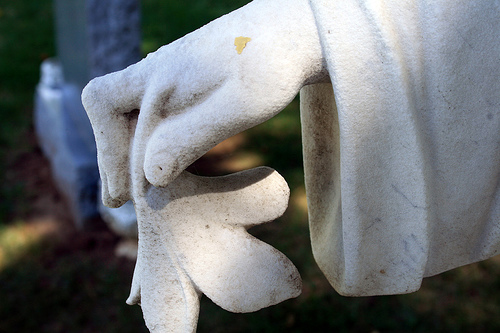
(*photo
by Janet Powell)
November 2, 2007 John W. Gofman (1919-2007)
"Licensing a nuclear power plant is in my view, licensing
random premeditated murder." Nuclear Witnesses: Insiders Speak
Out, 1982.
When we started the Center for Science in the Public Interest
in 1970, John Gofman welcomed us to share some of his resources at
his temporary work site in the AFL-CIO headquarters on 16th Street
in Washington, DC. His graciousness to these just-beginning public
interest scientists has never been forgotten. However, he was
great for far more than singular acts of kindness. John Gofman was
the medical physicist who helped give the first alert to the world
of the health effects of radiation. His pioneering efforts, along
with those of co-worker Arthur R. Tamplin, led to an early
scientific act of whistleblowing on the nuclear industry and helped
give him the title of the "father of the antinuclear movement."
John Gofman had worked at the Lawrence Livermore National
Laboratory in California and developed data the year before our
meeting with him showing that the risk from low doses of radiation
was twenty times higher than stated by the government. This public
revelation caused him to lose all public funding and eventually his
position in a government laboratory. Over time the conclusions of
his work were validated and thus he continued for a life-long
career of work on the effects of radiation on human subjects.
The honesty of John Gofman was overwhelming. He argued that
the Atomic Energy Commission, which was divided into the Energy
Research and Development Administration founded to promote the
development of nuclear energy and the Nuclear Regulatory Commission
(NRC) established to monitor the safety of the nuclear industry,
had only cosmetic differences and promotion was the key to both
groups. He was unrelenting and persistent throughout his critique
of both government and industry and was proved right many times --
a man who was ahead of his times, a prophet who spoke out but was
not always appreciated. However the long hiatus in nuclear power
development in America could in part be due to Gofman's voice --
but will that voice still be heard now that he is gone and many
panic about replacing fossil fuel derived electricity with still
more nuclear power?
John Gofman did not really retire. He worked right until the
end of a long life (88 years) on public interest concerns. He
helped found the Committee for Nuclear Responsibility, a San
Francisco-based advocacy group. He always maintained that there
was (is) no safe level of exposure to ionizing radiation. Even in
very recent years he argued with deepest conviction that radiation
is overused in medicine both for diagnosis and for treatment --
without a full consideration of the risks involved. He stated that
some hospitals use one hundred times the required radiation for
imaging. He also argued that "CT" scans are used all too
frequently with the availability of less dangerous approaches.
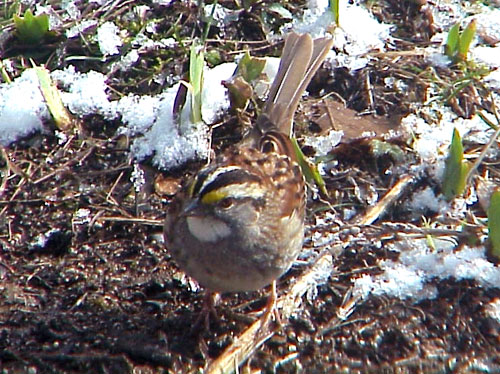
White-throated sparrow, Zonotrichia albicollis.
(*photo by Sally Ramsdell)
November 3, 2007 Nut-Gathering in Autumn
In springtime we gather greens; in summer, berries; and in
autumn the nuts. When I was young our family gathered two types of
nuts, since the wetter valleys and dales were ideal for black
walnuts and the forested areas were part of the oak/hickory
bioregion in which we lived. Walnuts and hickory nuts were the
staples and both bring back memories -- not all perfectly pleasant.
The black walnuts come with an iodine-smelling green-to-black
outer pulp that has to be removed. We would gather the nuts in
early autumn and then proceed to hull them with a wooden mallet --
and then place them in a dry loft to dry for several months before
eating. Unfortunately some of the stain from the hulling would get
on my hands and not wash off for a week or so. I was embarrassed
to go to school with walnut stained hands. Sister Victoria
(originally from a western Kentucky farm) noticed the ribbing I got
from classmates and told us all that "there is clean dirt and dirty
dirt -- and the first type one wears with dignity because it is the
sign of honest work."
The other type of nuts we gathered were the hickory nuts,
which come in a variety of species from what we called small "pig
nuts" to larger ones with more meat in the nut. My mother wanted
the latter because she made her famous holiday hickory nut cakes,
which required a month of nut-cracking and picking to get the
ingredients for her baking delights with the thick caramel icing.
We went each autumn to neighboring Appalachian Lewis County, which
had a multitude of hickory nut trees. My family had favorite sites
and would ask the owners for permission to undertake the hickory
nut gathering. The hulls of the hickory nut are not like either
the staining walnut or the prickly chestnut, with which we were
less familiar due to an earlier chestnut blight. However, once we
were at the site it didn't take long to actually gather a bushel of
smooth tan hickory nuts with the little spur at the growth end.
The hickory nuts were hard as rocks and only an experienced
cracker could break the shell without pulverizing the nut "meat"
itself or including fragments of shell in the harvested contents.
My mother developed a unique hickory nut picking skill and used
what is now an antique "iron" for pressing clothes. She put just
the right pressure on the downward thrust of the iron to crack but
not crush the resistant hickory nut. A day's work would yield only
about two cups of picked nut meat. In comparison, the meat from
thin-shelled commercially available English walnuts was rapidly and
easily extracted. The hickory nut gave a special flavor just as
the hickory wood was prized for curing meat.
Other native varieties are good for autumn gathering. They
include chestnuts, beechnuts and white walnuts that are more scarce
than black walnuts and hickory nuts. Besides, competition from the
squirrels for these types is quite high. Also we have American
hazelnuts (cousins of filberts) that grow wild on bushes but are
not as plentiful. However, all these are worth gathering.

Beautiful crocus, by Angela Stepp, angela (*at*)
shutterfliesandposes.com
November 4, 2007 Zacchaeus's House Is Our Earth
Today Salvation has come to this house. (Luke 19:9)
Zacchaeus is a little person among all of us who are also
little before the Lord. He is earnest and invites the saving grace
of Jesus to enter his home. We too need the saving grace of God to
help save our wounded Earth. And God's presence requires our total
presence as well for an authentic communication. The redemptive
work (soteriology) of Christ takes on added meaning when we see
that Jesus comes and saves us. This addition to our awareness and
enthusiasm adds to our actions, not his. And through this
increased awareness we are called to help save Mother Earth.
In the Gospel story Zacchaeus is disliked by the people around
him for he is small in their eyes both physically and morally. He
seeks to compensate by first climbing a sycamore tree to overcome
his physical disadvantage, showing hospitality, and then explaining
how he seeks to be doubly charitable. Jesus notices and enters
into his confidence and also his house. Jesus also comes to our
house -- our planet that is in such need. We are saved through his
blood and nothing of greater value can be obtained. However, the
story does not end with his suffering and death and resurrection.
We are to take the Good News to all creation and that means we have
a role to play -- And in my own body to do what I can to make up
all that has still to be undergone by Christ for the sake of his
body, the Church. (Col. 1:24) Jesus suffers in order to establish
the reign of Christ, and we are called to enter in and join our
sufferings with his. We cannot increase the value of Christ's
sufferings but we can make that value understood to others -- a
bringing of Good News. And the more we enter into the sufferings,
the more we can value that which Christ has already given value to.
Save Our Earth. Part of the Good News is for those who
actively suffer or indulge in the work that has to be done.
The saving of all Creation is done in the suffering and death of
Christ. No more needs to be done in that sense of actual
fulfillment, but we need to do more than see it as a past deed.
Christ suffers. We actively fulfill our mission through the
sufferings we undergo and thus we show what Jesus is doing in the
world around us -- for salvation is ongoing -- and we are invited
to be part of it as announcers of the Good News through word and
deed. And those deeds that we must engage in include decent
housing, adequate food and a livelihood for all on this planet.
Sufferers help in saving as well. The house is home to a
great number of us. Some can be active proclaimers of the Word and
others must give of themselves by offering their own personal
sufferings for their fellow human beings and for Earth itself.
Most of all, the manner of the offering must be joyful for thus the
Good News is truly good for others. And this requires active
participation. All of us, those who are active and those who must
endure passive suffering must join together and work to make this
a home for all and this involves healing our wounded Earth.
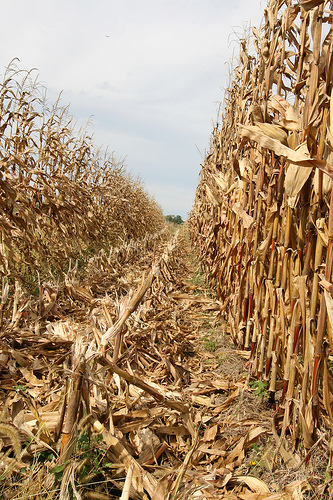
Harvesting of research plots, University of Kentucky farm.
(*photo
credit)
November 5, 2007 Planning and Energy Consumption
For much of this week we will discuss past and current
planning for a better use of energy -- a most needed exercise in
2007. Ever since Earth Day in 1970, noble attempts have been made
to alert the public to reduction in current fossil-fuel energy use
patterns and to move to a renewable energy/conservation economy.
These plans usually have targeted average conscientious consumers
or groups of people who are asked to take up the battle. No doubt
these approaches have been necessary to raise a basic awareness
that something ought to be done about the enormous use of energy by
the privileged rich of the world. One of the earlier attempts was
an action program entitled "Energy for my Neighbor," sponsored by
the Department of Church & Society of the World Council of
Churches. Since so much of this 1978 set of principles and
affirmations is still a propos of what we seek to do today, let's
review what was said three decades ago, for it was identical to
what we in the public interest were saying at that time in such
outlets as my book The Contrasumers: A Citizen's Guide to Resource
Conservation (Praeger Publishers, 1974).
1. We seek to be stewards of energy resources. We ask forr
better patterns of energy use because:
-- the looming shortage of non-renewable energy sources
coupled with rapidly increasing demands;
-- wasteful and inefficient energy use in our societies;
-- the negative social and environmental effects of high
levels of energy use.
2. We seek to share energy resources with our neighbors. We
recognize that the unequal distribution of energy use is a critical
factor in world poverty. We affirm the need to think of our
neighbors throughout the world when making local energy decisions.
3. We confess that we are presently violating the global ethic
that no peoples should consume energy resources or pollute the
earth through energy intensive activities at a rate greater than
the earth could stand if all peoples did likewise.
4. Therefore we seek a better way of living that is more in
harmony with the needs of the great majority of the people of the
earth and the earth's capacity to sustain our activities.
5. We recognize that there is an energy cost to every
activity, and that some ways of doing things are less energy costly
than others.
6. We affirm that energy conservation is the most immediate
and promising resource, and that savings can be enormous. Through
energy savings we seek also to care more for other materials and
for the environment as a whole.
7. Therefore we seek to change from a high energy fossil-fuel
based society to an intermediate energy society using renewable
energy resources.

Shaker Village of Pleasant Hill, Kentucky.
(*photo
credit)
November 6, 2007 Sustainable Energy Blueprint
A few months back, I promised Ken Bossong, the mover and
shaker behind the "Sustainable Energy Blueprint" that we would doo
justice to his current energy plan -- which is now "owned" by about
three hundred groups. This statement seeks to dramatically reduce
U.S. greenhouse gas emissions (U.S. 60-80% from current levels by
mid-century), phase out nuclear power, and end energy imports (now
58% in oil and 15% in natural gas) while simultaneously creating
new domestic jobs and business, improving energy, homeland and
national security and the economy, and enhancing the environment
and public health. The following changes are part of that
blueprint --
Technically feasible by 2025:
* Reduce total energy consumption by at least one percent/year
from 2005 levels, through efficiency improvements in housing,
manufacturing, vehicles, airplanes, government facilities, and
business so that by 2025 U.S. energy use totals no more than about
80 quadrillion BTUs.
* Increase from 2005 levels, production of renewable energy
from biofuels, biomass, geothermal, hydropower (and other water
power sources), solar and wind plus renewable-based hydrogen -- inn
an environmentally responsible manner -- by about 0.5 quads/year so
that by 2025 renewables provide at least 17 quads.
* Phase out the current generation of nuclear power plants byy
not relicensing currently existing reactors and not building new
ones (8 quads to 1 quad)..
* Reduce oil consumption by at least one percent/year below
2005 levels so that by 2025, U.S. oil imports are not more than
one-third of total petroleum use (39.5 quads to 27.0 quads).
* Reduce natural gas consumption by one percent/year below
2005 levels so that by 2025, the U.S. will no longer be importing
any natural gas ( 22.5 quads to 18.0 quads).
* Reduce coal consumption by at least one percent/year below
2005 levels (23.0 quads to 18.0 quads).
* Reduce carbon dioxide and other GHG emissions by at least
one percent/year so that by 2025 they are at least 20% below
current levels (renewables gain from 7.0 quads to 17.0 quads).
www.alternative-energy-news.info/sustainable-energy-blueprint/
Note: Two modifications are worth mentioning even though we at
Earthhealing are signatures to this Blueprint: first, biofuels
should involve only those that are not taken from current food--
producing sources; and second, the renewables could be still higher
if our nation launches our proposed Renewable Man on the Moon Project
(see November 9), which we hope the various presidential and other
federal and state candidates will endorse in the coming months.
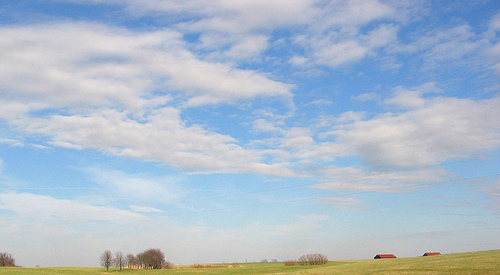
Mid-autumn Bluegrass sky, over rolling topography.
(*photo
credit)
November 7, 2007 Proposed Energy Policy Initiatives
We continue inserting materials from the Blueprint for
reaching the targets and objectives presented on November 6th.
1) By 2025, fuel economy standards for cars and trucks should
be at least double what they are today, beginning with a 50%
increase in fuel economy for new vehicles by the year 2015.
2) By 2025, total annual person-miles traveled by automobile
and truck should be back to levels no higher than today through
expansion of mass transit, better land use planning, telecommuting,
etc.
3) By 2025, no less than 25% of the nation's liquid
transportation fuels should be provided, or displaced, by renewable
sources, including renewably-generated hydrogen.
4) By 2025, no less than 25% of the nation's electricity
should be generated by renewable energy sources and increased by at
least 1 percent/year thereafter.
5) By 2025, state and/or federal standards should mandate that
the energy efficiency of appliances, motors, and lighting should be
improved by no less than 20% as measured on a total fuel cycle
basis.
6) By 2025, state and/or federal standards should mandate that
20% of all new buildings must be zero energy buildings (towards a
goal of all new buildings being zero energy by 2050), using a
combination of efficient design and clean on-site energy
production.
7) By 2025, energy use in the electricity sector should be
reduced by at least 10% through the use of clean distributed
generation such as combined heat & power, district energy, fuel
cells, and improved energy storage and transmission technologies.
8) Energy efficiency resource standards for electric and gas
utilities should be established with a target savings of at least
1% of annual sales each year, on an incremental basis, such that
savings build on previous years' impacts.
9) Expansion of renewable energy, energy efficiency and clean
distributed generation technologies should be promoted through
national interconnection standards, i.e., (net metering and
transmission access reforms), production and investment tax
incentives, government procurement, updated resource assessment,
and state and local planning programs.
10) Annual federal funding for the research, development, and
deployment of energy efficient and renewable energy technologies
should be at least doubled over the next five years, and expanded
to no less than five times current levels by 2025.
11) Funding to support sustainable energy budget outlays and
tax incentives, as well as to alleviate low-income consumer impacts
should be drawn from a mix of gradually increased dedicated taxes
on carbon-based fuels, energy imports, and fossil fuel leases on
federal lands.
12) Any new coal-based powerplants should be required to
achieve energy efficiency and environmental performance equal to,,
or better than the best available Integrated Combined Cycle Coal
Gasification technology...
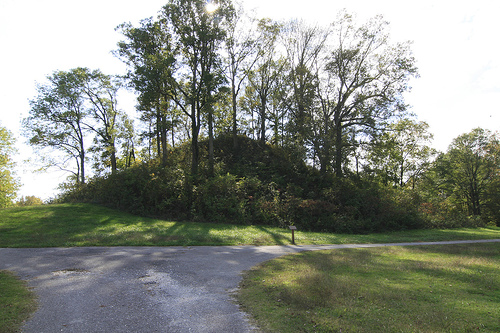
Mound #10, Pinson Mounds, the largest Middle Woodland period mound
group in the United States. Pinson, TN.
(*photo
credit)
November 8, 2007 Carbon-Free and Nuclear-Free
We continue this week looking at other advocates of a carbon-
free and nuclear-free world. We present here the findings of the
Institute for Energy and Environmental Research along with its
associated organizations in France and Russia. The following
summarizes the findings of Carbon-Free and Nuclear-Free: A Roadmap
for U.S. Energy Policy
www.ieer.org/carbonfree/.
1. A goal of zero-CO2 economy is necessary to minimize harm
related to climate change.
2. A hard cap on CO2 emission -- that is, a fixed emission
limit that declines year by year until it reaches zero -- would
provide large users of fossil fuel with a flexible way to phase out
CO2 emissions. However, free allowances, offsets that permit
emissions for third party reductions, or international trading of
allowances, notably with developing countries that have no CO2 cap,
would undermine and defeat the purpose of the system. A
measurement-based physical limit, with appropriate enforcement
should be put into place.
3. A reliable U.S. electricity sector with zero-CO2 emissions
can be achieved without the use of nuclear power or fossil fuels.
4. The use of nuclear power entails risks of nuclear
proliferation, terrorism, and serious accidents. It exacerbates
the problem of nuclear waste and perpetuates vulnerabilities and
insecurities in the energy system that are avoidable.
5. The use of highly efficient energy technologies and
building design, generally available today, can greatly ease the
transition to a zero-CO2 economy and reduce the cost. A two
percent annual increase in efficiency per unit of GDP relative to
recent trends would result in a one percent decline in energy use
per year, while providing three percent Gross Domestic Product
annual growth. This is well within the capacity of available
technological performance.
6. Biofuels, broadly defined, could be crucial to the
transition to a zero-CO2 economy without serious environmental side
effects or alternatively, they could produce considerable
collateral damage or even be very harmful to the environment and
increase greenhouse gas emissions. The outcome will depend
essentially on policy choices, incentives, and research and
development, both public and private.
7. Much of the reduction in CO2 can be achieved without
incurring any cost penalties (as, for instance, with efficient
lighting and refrigerators). The cost of eliminating the rest of
CO2 emissions due to fossil fuel use is likely to be in the range
of $10 to $30 per metric ton of CO2.
8. The transition to a zero-CO2 system can be made in a manner
compatible with local economic development in areas that now
produce fossil fuels.
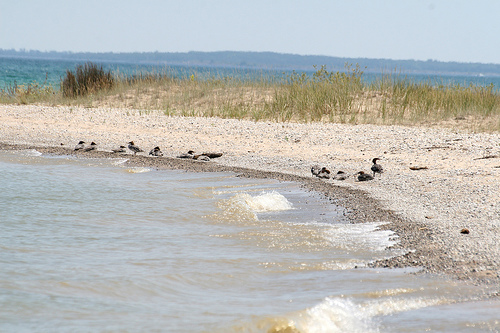
Common merganser, Mergus merganser
(*photo
credit)
November 9, 2007 A "Man on the Moon" Renewable Energy Project
One of the suggestions in the conclusion to our current
Special Issues on the Morality of Nuclear Power deals with a
possible Renewable Energy "Man on the Moon" Project. This is not
the proposal to return to the moon using renewable energy but
rather to initiate an immense national effort to convert to
renewable energy much like America's undertaking in the 1960s to
land a person on the moon -- and the goals were reached on
schedule. The same efforts could be focused today; global warming
is occurring and the climate change is having drastic effects on
some parts of the world especially among poorer native residents
(e.g., Bangladesh and the Arctic regions). A Wall Street Journal
article (7/9/07) argues convincingly that wind development is being
hurt by lack of equipment and not by the need for further academic
research. Equipment production could be a focus of our efforts.
Our Earthhealing estimates are that actual wind generators are
working within 50 miles of about 5% of our U.S. population, and
potentially feasible wind energy use could service about one-third
of America's population provided we put wind farms on the Cape Cod
coast, the Great Lakes, and the Jersey/Delaware coast. Off-shore
farms would make an immense difference. The IEER report Carbon-
Free and Nuclear-Free: A Roadmap for U.S. Energy Policy (11/7/07)
has many good things to say. However, the thirty-one renewable and
conservation suggestions are skewed in the direction of future
research and development. Most disappointing is the single wind
power (large scale, land based) entry, in which it states among
obstacles that "Areas of wind are not near populations." Tell that
to the people in Chicago, the windy city. The dismissal of wind
power (and the omission of lower level wind applications at homes
and farms), when wind is one of the five of thirty-one suggestions
listed as currently "commercial," is really unfortunate.
"Renewable America" (more details next month) needs two
directional emphases. First, forgetting the smorgasbord of
possible renewables would be far more helpful -- though the items
are certainly interesting as research and development projects. We
should concentrate our limited energy resources on what is
commercial available right now and initiate a crash program. Let
us be practical: we have plenty of practical renewable energy
sources (solar in many applications, wind, geothermal, hydropower,
some biofuels, and conservation measures such as energy efficient
vehicles and compact fluorescent lighting). New ones will help,
but promoting what works is best right now.
The second directional emphasis is not to expect a single
renewable source to be the full answer. If wind is not "near
populated areas," it is certainly near some and over a wide area of
lower populated areas. The same holds true of all other renewables
such as geothermal, which are excellent in some parts of the
country, moderate in others, and of lower worth in still others.
We need a mix of safe and ecological energy sources, not a single
magic bullet. Likewise we must conserve our limited energy
resources.
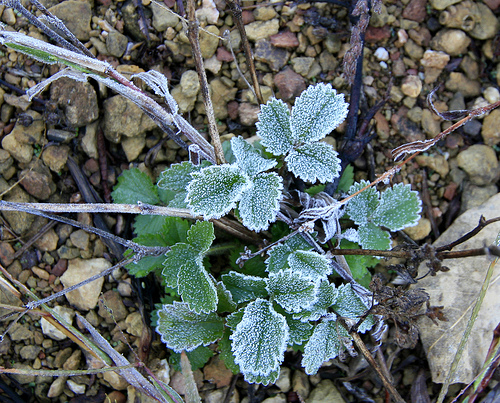
A first frost in Kentucky. Photo taken November 1, 2007.
Near Glasgow, KY.
(*photo
credit)
November 10, 2007 Soul-Searching about the War
On this weekend when we "celebrate" the 89th anniversary of
the ending of the war to end all wars (World War I), we find it
important to search for honesty in what this present conflict in
Iraq is costing the American people. It is already shaping up to
be the second longest war in our history (going on five years since
the initial invasion in March 2003) and that depends on how one
calculates the start and finish of the 1960-70s Vietnam adventure.
And the sheer length and failure to see an end in sight is taking
a toll on everyone, but especially on those militarily involved in
the Middle East conflict. First, the toll involves all the ones
who suffer: casualties and the loved ones of those fallen --
moving on 4,000 deaths and ten times that number of injured either
physically or mentally. What a loss of such good people who were
too willing to enter harms way! And what about the tens of
thousands of Iraqi caught in the crossfire of armed struggle?
Let us not forget the financial cost of the war, which I
predicted in its beginning in mid-2003 would cost "tens of billions
of dollars." Actually the estimates were way off for this war
costs hundreds of billions each year. What could have been done
with all that money in securing the infrastructure of this country
and in furnishing basic services to people in all parts of the
world? A non-military security could have resulted.
A great hidden loss in my estimation is that of the idealism
of the young who entered the military services in order to defend
our country and make the world a more secure place. After so much
sacrifice in time spent and risk to life and limb, some now openly
wonder what it was all worth. Was the defense that of the ready
petroleum supply so the folks back home could run their SUVs at
lower cost? Was the security for those who hardly knew that a
terrible war was being fought? Was it for the continued prosperity
of the defense industry? Or was it for the ultimate security of
four million internally or externally displaced Iraqi? When
harsher answers begin to emerge, youth dreams often give way to a
cynicism or a dropping out of the system all together.
People seem to get tired of our constant petitioning for peace
and yet we must do so. Far easier to get tired of our calls than
to tire of living or expecting peace in one's lifetime. To pray
for peace is to express a hope that it can and will come. However,
so much depends on our own efforts. For those who ask, "Well, what
would you do?" it is not satisfactory to say, "I didn't want to get
into the mess in the first place (and I said so), precisely because
I did not know how we would get out once we sunk in the quicksand."
It is far easier to get in than out. Ultimately, the Iraqi people
must decide themselves -- but merely dividing the country into
three parts may not end the bloodshed, especially among the various
Shiite factions. A hope is that the Iraqi will settle differences
for the good of all -- even if their country was the invention of
Western Powers after World War I's break-up of the Ottoman Empire.
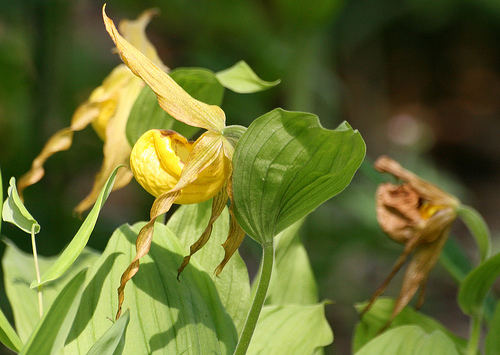
Yellow lady's slipper, Cypripedium pubescens
(*photo
credit)
November 11, 2007 Reflections on the Hereafter
This is an ideal day to reflect on those four last things that
seem to be more appropriate to November than to any other month,
for today is Veteran's Day when we recall the many who gave their
lives for patriotic causes. And these Sunday readings add to the
atmosphere by telling in the second book of Maccabees about the
seven brothers who died for their faith. In the Gospel (Luke
20:27-38) we read about the Sadducees, who claimed no resurrection
of the dead, trying to trick Jesus as to which of a succession of
husbands would enjoy heaven with the widow. Jesus gives us the
first hints of the afterlife for the just: it does exist; we
cannot imagine the manner of life there, which will be quite
different from what we experience here and now; and the dwellers
will no longer be liable to death. Those are broad strokes.
These three points should satisfy us in one way, for our
efforts are not to imagine precisely what is ahead, but to strive
to attain that goal here and now. However, that striving does not
mean we act as though we are Sadducees. If there were no
resurrection, then as St. Paul says, our faith would be dead and
there would be nothing to look forward to. Those who expect a
blank wall ahead can only expect to leave a fading mark on this
changing world, a mark that grows fainter as the ones we knew and
love pass on and fewer know our name or our few weak achievements.
So the "immortality" of descendants has its dying breath. Where is
hope? Where is eternal Love with such a stance?
Resurrection enlivens us. Believers have a broader vista that
opens before them in an awaited future. The promise of a New
Heaven and a New Earth somewhat removes but not totally separates
us from the non-believer. We both share current life in its mortal
nature; we both do not totally know the future; we both hope for
the best. Here the difference is one of faith in resurrection, and
that is not to be minimized; faith enters in the way we conduct our
lives. Our anticipation of this life as transitory and a phase and
not a terminus gives precious meaning to what life is all about and
energy to our undertakings. Our faith transcends the cynicism that
confronted Jesus in today's account by Luke -- and confronts us
today. What we see in faith is a world struggling to come to some
meaning in life and seeking a sure ground for that meaning, a
ground in time and a time that looks to the future -- to eternity.
What we do not know is the very nature of the newness of that
eternal space -- what precisely is a New Heaven and a New Earth?
The promised change is to be profound as Jesus indicates in today's
reading, but we are left not knowing what it is. Maybe it is
enough that we not speculate or gaze about, but turn ourselves to
this Earth and the troubles facing us here and now. However, the
Gospel invites us to do more. We are to affirm our belief in the
resurrection. We are to show the enthusiasm that this belief
engenders within us. We are to show a determination to prepare for
the New Heaven and the New Earth. By believing in an eternal
future we make the present ever more meaningful.

Close-up of Bearded Robber Fly, Asilidae sp.
(*photo
credit)
November 12, 2007 Beware of Scam Artists?
In this world of easier access to global communications we
suffer from the twenty-first century equivalent of fake patent
medicine purveyors, frauds, prophets of doom, fortune-tellers,
witch accusers, and the charlatans of past centuries. Today a new
breed of those past disturbers of the peace exists: the scam
artists of the twenty-first century. We find them at the door, on
the phone, on the television, over the Internet, at the street
corner, in the university dorm, and in every conceivable place we
venture out into. Every so often we hear tales of people being
taken by their dishonest offers of get rich schemes; these poor
victims lose their credit card confidential information and each
story seems more tragic than the last.
When the phone rings and the caller asks to speak to the owner
of this business I tell them to go pray, for God owns this place.
Over the years I hardly know how many emails I have received that
had to be deleted -- virtually all of these unsolicited ones
attempt to entice me to take a double look at what they have to
offer. They can be clever though we average folks are becoming
aware quite fast. Door bell ringers are still another group that
must be tolerated and treated each in his or her own way.
Interruptions are certainly worrisome and a challenge for those
trying to practice patience.
Avoiding some of this is not easy. I do not have credit cards
and I write this reflection on a computer that is not
attached to the Internet. And I try to size up the caller at the
door or phone quite quickly. However, the frustration is not
totally relieved. And there is only so much that any one
individual can do. However, stiffer fines for violation of privacy
rights or for fraudulent practices that prey on the elderly and
vulnerable could be forthcoming and will be most welcome. The
added frustration to us all is that the successful scam artist is
usually one step ahead of legislation and knows one more way to get
around the system. Scam artists are the tares in the grainfield.
A few suggestions that may add to our vigilance could include:
* Don't give out confidential information unless absolutely
necessary and then with safeguards. An arrogant clerk in a motel
asked for my social security number. I reminded the clerk that
this number was given for confidential use by the government and
could not be so demanded. And so I was reminded to look for
another lodging.
* Make sure the vulnerable do not have control of financial
resources that the scams can penetrate. Youthful or elderly credit
cards or bank accounts are subject to misuse and should be
controlled.
* Report the scam artists when what they are up to is
apparent. Our ignoring them only makes them all the more bold. If
big brother is watching them, they may be discouraged to some
degree.
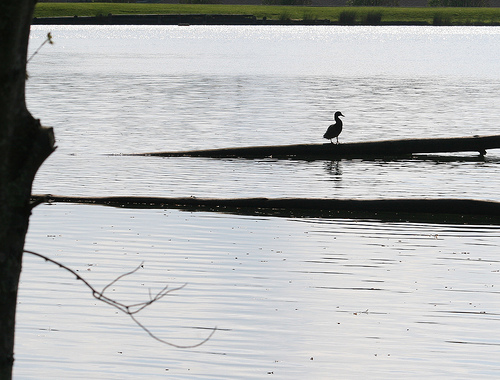
A quiet moment by a pond, a lone duck grooming on a
partially-submerged log
(*photo
credit)
November 13, 2007 Creating Sacred Space
In the past we have sought to discover sacred space in our
hearts (3/11/04) and in formal places such as churches and shrines
(9/28/06). As committed Earthhealers we look about and either
discover forgotten arenas of natural sacred space or undertake aa
more heroic venture of re-creating what was wounded.
Discovery: Look for areas that fit the categories of space
that stimulate our senses to thanksgiving:
Sight -- Look to the beauty of creation and see places to
observe brilliant sunsets, colorful flowers, verdant forests, the
movement of the ocean waves, the floating clouds.
Touch -- Reach out and touch the living things around us: the
bark of trees, the feel of the leaves, the softness of petals, and
realize at the time that paved surfaces and urban lighting have
distanced us from natural phenomena.
Sound -- Listen hard and hear the natural sounds of thunder
and rushing water, or the more gentle sounds of songbirds and
crickets, gurgling creeks and peepers. Reflect on the pauses that
make for the harmony of sound and silence.
Taste -- Search about and find something that can be tasted in
the landscape, at least during part of the natural growing season:
berries, fruits, nuts, herbs, sassafras bark, or even a friendly
mushroom or lichen (when you are familiar with types).
Smell -- Take in the aroma of the surrounding fresh air for it
is different for each season and for each climatic change. Smell
the particular vegetation all around, fragrant flowers, evergreens,
and even the decaying leaves in autumn and winter.
All the senses can turn our hearts and minds to God. However, we
can also find in damaged landscape the ugly sights, the foul odors,
the moaning sounds, the taste of despair and the feel of
disharmony. However, with our senses we can be drawn to refresh
ourselves, and to be sensitive to the needs of others.
Re-creativity: Accept the responsibility of finding God in
remaking the landscape through the use of senses:
Sight -- Clean up the roadside litter even when you did not
throw the materials thoughtlessly away and see the refreshing look
of what has been cleaned.
Touch -- Feel the weight of a shovel full of upturned soil as
you dig a hole to plant the sapling that will cheer a denuded
landscape -- and be assured that it is a wonderful experience.
Sound -- Hear the excitement of those helping to build a
nature trail for others to enjoy on a portion of land that has been
damaged.
Taste -- Taste the home-cooking of those who appreciate your
coming and helping with home insulation and repair of their humble
dwellings.
Smell -- Take in the whiff of wood smoke as you burn the
briars and untangle the choked landscape so that native species can
grow once again. Caution! Don't burn the poison ivy.
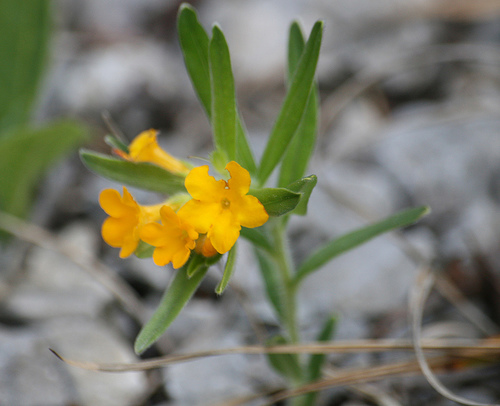
Hoary Puccoon, Lithospermum canescens
(*photo
credit)
November 14, 2007 The Time for Pears
November is the end of the growing season in our part of the
country, but I have remembered times in the past when we went out
in the frosty season and gathered the autumn pears (the summer ones
would have been picked several months before). These pears had
fallen on the ground amid the autumn grass and were inviting us to
pick them up and take a bite. They were candidates with some late
fall apples and the native persimmons (that needed a frost to
ripen) for the last fruit of the growing year. And these "winter"
or "late fall" pears were good candidates for cold storage in our
root cellar, for they would remain hard and crunchy and not become
soft and mellow like the earlier ripening ones. Much about the
sensations of apples (September 25, 05) that were mentioned before
in these reflections also applies to pears, for they also can look,
smell, taste, feel and even sound in their own distinct way when we
enjoy them in their raw form. Why cook an autumn pear?
November falls at the end of our temperate growing season and
just before the citrus fruits (oranges, nectarines, lemons, limes
and grapefruit) come in from points south and fill up the fruit
cravings of the holiday season and mid winter. Thus this
intermediate season is the time for the stored apples and pears --
and that is a time of fruitful joy as well.
Pears are best untouched by knife or the cooking stove, just
eaten one bite at a time, and are even a good fruit for sharing a
bite with another. Pears are clean and respectful and do not
crumble like peaches and plums after the first mouthful. They
remain dignified to the very end. And they can be consumed to the
last drop with hardly a core to leave as a residue.
People have thought up many ways to preserve the pear beyond
the raw state but these ways may be fewer than that of the trusty
apple. They give us the following:
pear preserves, pear butter, pear cobblers, pear pie,
pear juice, canned pears, dried pear hazelnut stuffing, wild
cranberry sauce with pears, mixed fruit salad with pears and
raisins, fruitcake with pears, pear chutney (with ginger),
Gewurztrammer poached pears, acorn squash with pears, pear thyme
and rosemary sorbet, and on and on. Believe me, all of these aree
quite tasty and yet, when all is said and done, the raw pear tops
them all. Taste and see the goodness of the pear.
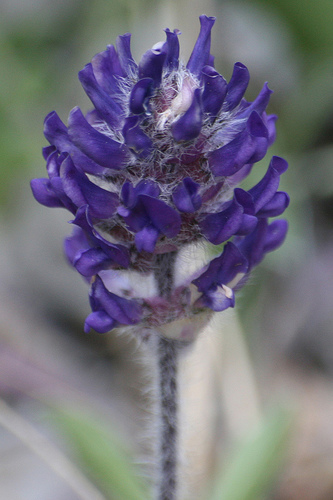
Nashville Breadroot, Pediomelum subacaule
(*photo
credit)
November 15, 2007 Who Redistributes the World's Resources?
The world's wealth and resources do not belong to a select
few; they also belong to the poor. (Benedict XVI, 9/5/07)
On Use Less Stuff Day we should reflect more deeply on who
uses what each of us thinks we "own." At least we surmise that
there is no conservation police out there to rap the hands of the
wasting person. And we think of weak governance only in poor lands
of Africa, where conflicts over water resources are cropping up
more and more during the destabilizing conditions brought on by
climate change and excessive rains or lack of rain. However, poor
governance is also a condition of many parts of the world including
the so-called developed nations that allow their privileged few to
squander world resources -- water, land, trees, and petroleum.
This owning what does not belong to us most likely comes
through some trumped up fiction of colonization by the privileged -
- a concept prevalent for hundreds of years. And this social and
economic facade is supported by national myths that we can use what
we "own" better than natives who do not exploit them. Resource
finders become keepers. However, social justice tells another
story; the limited Earth's resources belong to all the people.
This raises the question that seems to grow in urgency with each
passing year in times of ecological crisis. How can those deprived
of resources through their lower status in the social system obtain
or "take" what is rightly theirs? And can this be done without
violence as is now occurring between settled (farming) and pastoral
people in Sudan and Chad? Limited access to resources breeds
internal and external violence.
Thus for the Christian with a moral sense, the basic question
of who owns world resources is quite simple: we all do. However,
the discussion only begins there. Who can retrieve those resources
and make sure they are redistributed to those who need them most?
Thus the ownership question becomes a redistribution one. One way
of conceiving of the answer is to say the poor or the lowly will do
this in a revolutionary manner. However, that could lead to
violence as already witnessed in our increasingly terror-filled
world. The second more idealistic hope is that all parties will
sit down and come to an agreement where the resource-lacking make
their pleas and the resource-filled will voluntarily empty their
coffers in utter largesse. The first scenario is a real
possibility; the second would be a miracle and we do not make
global environmental policy on the basis of possible miracles.
Thus we return to a message mentioned numerous times in
various ways in these reflections: we need to sharpen the
governance on our country and world to moderate through regulation
the use of resources so that all have the basics of life and those
who squander will be placed under tight control. Here churches
have a role to play; we must strengthen the will power to change.
Sharing ownership by the few with the many should occur in a
peaceful manner through better and more democratic governance.

Fresh laundry, hanging out to dry
(*photo
credit)
November 16, 2007 The Right to Dry Clothes Outside
Across the United States, there are 300,000 community
associations. Most of them ban or restrict the clothesline.
"Right to dry" legislation is in the works in several states to
adjust these rules, but what is needed is a shift in values. For
the sake of the Earth, we must all begin to regard the clothesline
as beautiful again. It is colorful, organic, utilitarian, and even
sentimental or nostalgic for some. A. Lee
Our New England lawyer and environmentalist friend, Alexander
Lee, has carried on a crusade to legalize the time-honored clothes
line for drying washed garments. It sounds so simple and yet he
perceived that a rash and wasteful public policy has promoted the
ban on clothes lines in many parts of our country because they seem
to be unsightly and not modern. Alexander points out the clothes
dryer is a major user of electricity; fresh air and sunshine are
excellent drying environments with no use of precious electricity
and the fuels used to generate it (see 4/19/04 National Hanging Out
Day). Other advantages listed include saving more than $100 a
year, better smelling clothes and sheets, clothing lasting longer, a
chance for physical activity and reduction of chances of clothes
dryer fires.
Hang ups. I know clothes lines seem to many as not the major
issue of the day -- but there is something to be said for the
practice and about our addiction to energy including the less
important but energy wasteful clothes dryer. Why shouldn't people
hang their clothes out to dry as for millennia? Are people afraid
of seeing what others wear underneath -- and if that offends the
user or potential viewer, why not a wood or vegetative screen to
hide the drying articles? In fact, it is the regulations to do
away with the clothes line that are most offensive. How much of an
addiction to energy motivates the local regulators?
Hanging out. And now with the controversies on global warming
up, the clothes hanging restrictions are hanging out. Alexander is
now being discovered after a decade of patient work on this issue,
and media groups from the Wall Street Journal to regional public
radio stations have approached him for stories. And why not? More
and more people in sophisticated portions of America will feel
incensed that they are being told to continue in their wastefulness
and use electricity to do what fresh air and sunlight do well.
Hanging together. The insistent and creative Alexander Lee is
now is establishing groups throughout the country to promote
outdoor clothes line. He does not like being sequestered within a
small but dedicated group; he hopes this expands into a movement.
Encourage state legislators to introduce a "Right to Dry" bill or
solar rights legislation. Also register communities that prohibit
the hanging out of clothing. The time has come to think locally
and act globally and this is a good place to move from domestic
concerns to community-based ones. If interested, visit the website
of Project Laundry List
and contact <alee [*at*] laundrylist.org>
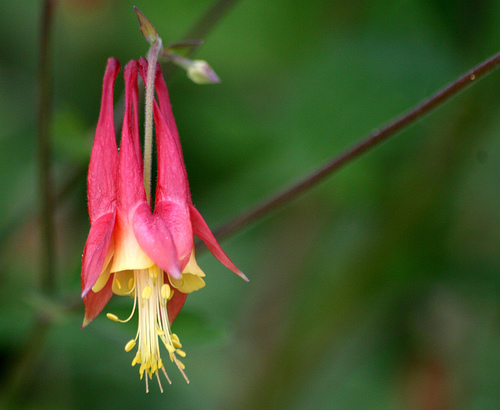
Native Kentucky columbine, Aquilegia canadensis
(*photo
credit)
November 17, 2007 Wars Triggered by Climate Change
As our church year draws to a close, we read Sacred Scripture
of tales of wars and rumors of wars. And they do seem to be
occurring. A recent BBC news program predicted that several
conflicts triggered by climate change will happen.
Africa. One of these climate change triggered conflicts is
occurring in Sudan's Darfur region and neighboring Chad. Here
grazing tribes are in conflict with settled farmers because both
want to graze and farm the same limited land. As the weather in
Africa becomes dryer, other conflicts will inevitably occur
especially in the Sahel and bordering areas. In northern Uganda
and in neighboring Kenya tribes vie for rights to water and grazing
land as well. Climate changes combine with population pressures,
and even on game preserves neighboring hungry people press for bush
meat (wild game) and livestock grazing land. The twenty-first
century may see such pressures expand and intensify in many parts
of Africa. Will the compromises and just allocations occur?
Middle East. Climate change, population growth and economic
pressures will result in regional conflicts in Syria, Jordan,
Egypt, Palestine, Israel, Iraq, and Turkey to name but a few. One
cannot expect fresh water swimming pools in one armed camp and
desiccated orchards and grain fields just outside the borders. The
damming of rivers upstream will exacerbate conflicts when people
downstream see the rivers reduced to a trickle. Inland areas will
suffer most even if solar technologies may allow for turning saline
ocean and gulf water into fresh water. The affluent and luxury
users have a way of setting unsustainable policies, but that cannot
continue as business as usual when the rapidly growing climatic
changes continue to have impact.
Asian surpluses. Bangladesh is down stream and in a flood
zone of Nepalese and Indian rivers. Earlier this year vast areas
of all three nations were inundated by floods. The delta lands are
inhabited by tens of millions of people, many of whom depend on the
proper flow of the rivers to furnish water for crops and drinking -
- but not too much of a good thing. At times half of Bangladesh is
knee-deep in water. Too much is as bad as too little water as
flood-prone Appalachia and Mississippi delta folks will attest.
Certainly, one alternative is moving residents to higher ground.
Potable rain water storage cisterns and houses that rise and float
in place with a flood are expensive propositions for many Asians.
Climate change is before us with challenges this world did not
have to face even a century ago. A United Nations body devoted to
settling conflicts before they become acute is most necessary.
Such foresightedness would be far cheaper than the costs of the
conflicts once they blaze. But the body must go beyond emergencies
once they arise. A longer-term outlook includes curbing the
wasteful consumption of goods that causes the grave consequences --
and this directly affects our own lifestyle practices.
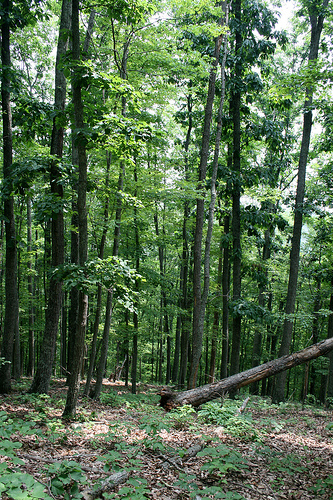
Serene view of the forest, through the trees
(*photo
credit)
November 18, 2007 The Day of the Lord
And when you hear of wars and revolutions, do not be
frightened, for this is something that must happen but the end is
not so soon. (Luke 21:8b)
In this media-sensitive world, we hear in matters of minutes
or hours about earthquakes, hurricanes and wars in distant places.
Not a day passes without some disaster in some location -- and we
know about it almost instantaneously. In fact, such ongoing events
can wear us down and for a few they indicate that the world's end
is coming quite soon. Perhaps one could make a case for the
world's end at any time since the Gospel of Luke was written -- and
it would sound convincing. All we know for sure is that we do not
know the day or hour, though some scam artists say that they have
the inside story.
Caution! Quite often Jesus tells us not to be frightened and
this message again appears at the end of the Church year as we
prepare for the Feast of Christ the King next week and the seasons
of Advent and Christmas. When we hear the word "end," it does
bring on some foreboding, but should it? When something shocking
happens we can become drained. If the event is expected then it is
somehow less stressful. Just anticipating a calamity diverts our
attention from the tasks at hand. In the course of these
reflections we have constantly emphasized the task of healing our
Earth. This is a serious work involving the cooperative efforts of
the world's people. When we have the foreboding just mentioned we
forget about the collective efforts and think again of saving our
precious necks or those of our family or community. However, Jesus
expects more of us.
That Day. Speaking about the end we hear talk about the
terrible day of the Lord -- Dies Irae (Latin for Day of Wrath) from
the ancient song that was sung at funerals. The prayer within thee
song was to deliver us from a judgment that we justly deserve --
and that we did not prepare for. Freedom from the excessive fears
of those who refuse to reform their lives is what we seek.
Possible condemnation is not a welcome specter
Our Day. We are to make every day a day of the Lord, not just
the Sunday or feast day or special occasions in our lives. We are
the Lord's and all time -- even our own -- ultimately belongs to
God, and we are given this span as a special gift. Thus we are
called not to waste our energy in meaningless ways, for the end is
not yet -- and the period of the "yet" is the gift to do something
meaningful for the Lord. Thus that day becomes this day. We make
this one the most important of any that we have lived.
Hold steady in life. St. Paul tells us to be good workers
through all the conflicts that beset us in life. We are not to be
idle and await the end as though our salvation is assured and all
we need do is wait in patience. Nor are we to be busybodies and
interfering in areas that are not of our concern. Let us work on
at a steady pace and find the Lord in our lived experience.
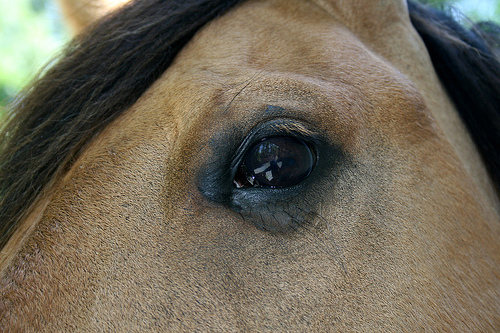
Close-up of the eye of a work horse
(*photo
credit)
November 19, 2007 Lincoln and Emancipation Today
On the 144th anniversary of the delivery of Lincoln's
Gettysburg Address (see 11/19/04) we return to the struggles of
that Civil War. We recall Lincoln coming to the determination to
free the slaves as part of the act of preserving the union (Ref.
Lincoln's Emancipation Proclamation: The End of Slavery in America,
by Allen C. Guelzo (Simon & Schuster, 2004). What this book has
recently impressed on me is that the emancipating act that was such
a struggle for Lincoln had much to do with practical affairs:
threats from border states, a possible coupe by George McClellan,
defeats on the battlefield, a deep racism on the part of many
northerners, a hesitant cabinet, personal tragedy with the death of
a son, and the rising costs of war and maintaining a large army.
Application today. Today, it is not slaves that must be freed
but those caught in the throes of destitution. What Lincoln did
bears remembering because though history does not repeat itself, it
does take similar paths at times. We too are faced with a great
global conflict, as to whether this or any world can survive half
destitute and half wealthy. What we face is of equally great peril
because there is a world, not one nation, at stake. Today we need
leadership to help bring about a proclamation -- a spreading of the
Good News takes committed people as well.
Differences. Lincoln faced the issues of his day trying to
balance between states in rebellion and those border states
(Kentucky, Maryland, Delaware and Missouri) that wanted to preserve
the union and still retain slavery. Today, most nation states are
not in civil war but they are faced increasingly with civil strive
caused by terrorism that emerges in many forms. And many want to
keep the world peace and still tolerate world destitution -- border
nations that include our own.
Similarities. Lincoln wanted to save the union and that was
always his main goal -- and he was willing to make a number of
compromises in order to achieve this overriding goal (a scheme for
colonizing ex-slaves, a compensation program, etc.). When he
became aware that this country could not exist half-slave and half-
free he realized that preserving the union required a deeper
commitment that he was at first reluctant to make, namely freeing
the slaves, which he was convinced would happen over time.
However, he saw that he had to hasten this and put this action to
prayer and vow.
Today we see that we must save our Earth and that this is a
goal that reaches out and includes more than just certain leaders;
we are all committed to this task. In order to do this we are
awakening to the fact that we cannot save Earth without freeing all
people from destitution. Furthermore, though this process like
emancipation could be better if compensated, gradual and with the
vote of all specific governments involved, it may have to go
beyond. Saving this Earth includes lifting people from
destitution. We cannot remain a planet of haves and have-nots.

Spirobolid Millipede, Narceus americanus
(*photo
credit)
November 20, 2007 Lead and Children's Day
It was not too many years ago that lead became recognized as
a toxic material that needed to be prevented from getting into the
environment; see "Lead Paint" (5/16/05) and Lead in the Home
(12/14/06). This year safety officials have spotted a fair number
of toys coming into our country from China with lead paint. No one
would doubt the attractiveness, luster and lower price of that
paint, but our people are wary of children who tend to touch things
and put their hands into their mouth -- and so the anxiety about
these leaded toys has grown immensely.
The U.S. Centers for Disease Control and Prevention tell us
that about one in twenty-two children in this country has high
levels of lead in his or her blood from a variety of sources such
as dust, paint and soil. In the past, lead was used in water
pipes, gasoline and of course the house paint that still coats many
of America's older homes (though now covered by non-lead varieties).
However, lead can chip off and infants can find these chips. Thee
four or five percent of affected children can suffer from learning
disabilities, impaired hearing and even brain damage. All of these
problems can be avoided by removal of the lead from the
environment, as there is now no American leaded gasoline or paint.
Now awareness extends to foreign imports.
The U.S. Environmental Protection Agency offers some simple
practices to help protect susceptible children:
* Testing -- Children at ages one and two who may appear
healthy may have high levels of lead, especially if exposed to high
levels of lead in toys or from the paint chips and dust in older
homes. If not sure the child has high lead levels, a blood test
will at least help restore your peace of mind.
* Cleaning -- Children like to play around a place. The yard
of an older painted home may have lead in the soil -- and some
soils were contaminated a long time back. Wash the bottles, toys,
stuffed animals and other objects that the children use frequently
and clean the floors, window frames and other surfaces.
* Reducing risk -- Homes that are about forty years or older
will most likely have been painted once at least on doors, window
sills and even siding with lead based paints. Make sure the child
does not chew on chips from this or from older play pens and cribs
covered with a former coat of lead paint.
* Removing lead paint -- If lead paint must be removed, get
a person with special training to do the job. Don't do it
yourself. Local and state health departments can give advice after
performing the lead testing to determine whether this is necessary.
* Avoiding dust -- Have the children play in sand or grass
instead of in bare dirt, even though they may prefer dirt.
And make sure their hands are washed after playing outdoors.
* Using water -- Use only cold water for drinking, cooking,
and preparing baby formula and run the stream 15 to 30 seconds
before using. Old piping may be suspect. Thus get water tested.
* Storing food -- Don't store food or liquid in crystal
glassware or imported or old pottery.

Three expressions of a black labrador retriever, the sincerity of
our animal companions
(*photo
credit)
November 21, 2007 The Roots of Violence
National Stop the Violence Day
Our troubled Earth includes: victims of warfare, poverty and
disease and landscape that is eroded, denuded and drought-stricken.
We know effects of violence more than its causes and these can be
many. Some place the root of violence in the devil; others say
that money is the root of evil; others place the onus on the quest
for power or fame or fortune; still others say that our culture
breeds violence by condoning television shows, movies, computer
games and other types of entertainment where violence has a
prominent place. What makes some cultures more violent than
others? Here are eight of these characteristics that must be
highlighted and challenged but undoubtedly there are more.
Overcompetitiveness that leads to disregard for the people who
are neighbors and actually neglects to bless those who come inn
second or third or last -- thus creating violent reactions on a
par with the competitive practices themselves.
Selfishness that fails to see the other as worthy of his or
her own dignity and thus overlooks or hurts other people.
Animosity that continues old barriers which separate people
from each other due to race, culture, religion, locality or other
differences and allow these to continue to influence behavior.
Greed that champions the retention of property and wealth as
something to exclude from others and not share with them. The
inability to radically share in a world of growing limits on
resources affects all parts of the globe and can lead to the
conflicts mentioned about on November 17th.
Wastefulness that does violence to the limited resources for
others present and for future generations. While greed leads to
monopolistic possession, assumed privilege leads to consuming as
one likes and thus the continuation of inherent wastefulness. This
practice damages land, water and air and violates the right of all
people to clean air and water.
Self-righteousness that inclines some to violent reactions
because they are right in what they do and are. They never
question their own manner of living as being excessive.
Readily available weapons that make the owners feel a sense of
power and ability to frighten or intimidate others into submission.
The power of more technologically advanced weapons grows and some
of these can become weapons of mass destruction.
Destitution that can trigger desperate measures by victims to
stay alive and obtain the basics of life. The inability to improve
one's status can lead to violent reactions, which have a certain
degree of justification.

Close-up of sunflower, Helianthus sp.
(*photo
credit)
November 22, 2007 Simple Thanks
Thanks for the spark that gave me life,
the moment of joy and that of pain,
the time good folks made ready and brought me forth,
the family warmth to receive and nurture us all.
Thanks for the waters that cleansed me,
the bread that sustained me, the oil that strengthened me,
the words that renewed me.
Thanks for the joy of youth, the fresh air,
the freedom to explore,
the liberty, the promise yet unconquered,
the hopes for a future and better days.
Thanks for the books, the schools, the sacred times,
the power to read and write and think,
the places and zest to go,
the rest and silence in just staying.
Thanks for the colors we see, sounds we hear, smells of fall decay,
the feel of rusty leaves soon to pass from sight,
the taste of good cooking.
Thanks for all of these and the power to move,
and climb, and skip and jump, and dance,
and crawl and jog, or at least to be satisfied
not to have all these movements.
Thanks for the peace and our own hope to establish it,
for love and to be loved,
for faith and to be trusted,
for happiness and the times of sadness with others.
Thanks for the glorious sun in the morning,
Whippoorwills, the heralds of evening,
Mourning doves, the announcers of spring,
Crows, the voices of the autumn.
Thanks for letting us grow up,
for responsibilities and concerns,
for labor and sweat,
for achievement and knowing when it fails us.
Thanks for gray hair and strength to be wise,
for the memories and good times to recall,
for the chance to see our failures and learn from them,
for the knowledge that it's never too late.
Thanks for allowing us to endure,
to live fully each moment,
to know that quality of days, not length, are important,
and to live once more.
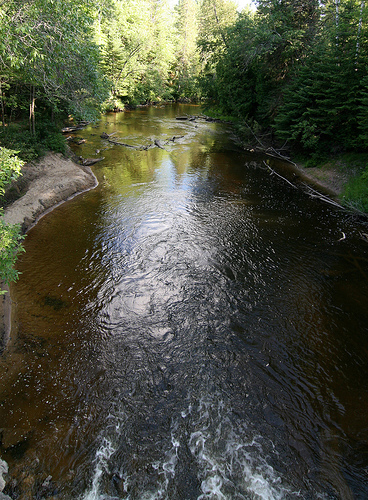
Downstream of the Carp River, St. Ignace, MI
(*photo
credit)
November 23, 2007 Piety: Enhancing the Sense of Mystery
Piety is the gift of the Spirit that inspires us with a tender
and filial confidence in God, making us joyfully embrace all that
pertains to the divine service. A distinction needs to be made for
this and fear of the Lord (the last gift of the series) are closely
associated and often regarded as a single one. We seek the
attitudes that we must graciously embrace (piety) and the reverence
that embraces a humble acknowledgment of our limitations gained
through wisdom with its emphasis on confidence (fear of the Lord).
Mystery is always before us, and from it springs forth a basic
enthusiasm or the God within. On the other hand, those with
genuine piety feel the presence of God within individual and
communal journeys of faith. Our mission is filled with the Spirit;
creativity abounds; an interior energy swells up and spills over in
action; we are enlivened. Thus piety is far more than
scrupulousness and proper conduct at given times of worship; piety
is loyalty and devotion to the specific mission that we are
undertaking. It is not a rote pious act performed out of custom,
but rather is performed with enthusiasm and care.
We are pilgrims into the unknown? We are all drawn by Mystery
and yet we are tempted to insert other causes, names, idols, and
crusades in our inability to define absolute "Mystery." For to
define this ambiguous word is to restrict it beyond its unlimited
characteristics. Why do we continue to search? Is it because, as
St. Augustine says, we cannot rest until we rest in God? Are we
being drawn by something and we know not what. Accepting Mystery
is comforting for it allows us to accept the other gifts -- our
limitations, our insights, our ability to choose, our willingness
to take risks, and to begin to see where they are leading. Even if
Mystery is the source of our restlessness, it gives us
encouragement, direction and bearing. Gradually we come to realize
that our journey is not one of conquest but of surrender to the God
who calls us. Only from a distance do we have glimpses of the Holy
Other whom we cannot see or fully embrace.
Application: A sense of mystery is an atmosphere in which one
breathes the fresh air of freedom, not to do whatever one wants,
but to do what God wants in an extended freedom. To do what one
wants is to close one's mind to the possibility of eternal quest
and limit oneself to the lifeless idol of self. We approach an
infinite Mystery freely. Claustrophobia yields to healthy air and
the atmosphere becomes breath-taking. Mystery is the deepening
gift of the Spirit that enhances our quest for the unknown.
Mystery is not agnostic; even admitting that we cannot penetrate
Mystery does not mean we confess lack of knowledge -- or abandon
desire for knowing more. We know God through revelation and thus
we turn to the Mystery of God within our hearts. The prophet
Ezekiel speaks of conversion of heart. Mercy, not sacrifice; love
and not hearts of stone; these are the indicators that the quest
for Mystery is a movement of heart -- and one undertaken with
enthusiasm and earnestness.
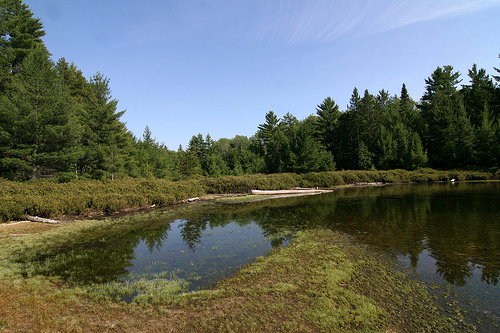
A rich wetland, alive.
(*photo
credit)
November 24, 2007 Beavers and Natural Wetlands
Tonight we can observe Full Beaver Moon and thus it is
appropriate to select this busy little namesake as the wildlife of
the month -- and it is also the national animal of Canada. Among
the beaver's marks of distinction is that it is the "keystone" to
creating new wetlands and so we couple beavers and wetlands though
they are not always found together.
American beavers (Castor canadensis) are those cute
semiaquatic rodents that we both love at a distance and hate if
they decide to move next door. Next to the human being, this
animal has the greatest potential to change the bioregion through
its diligent construction of stream dams and cutting of the trees.
In fact, in South America many regard beavers as menaces or pests
and worthy of extermination, and some North Americans agree. Up
until a few decades ago beavers were commercially prized for their
fur, but they were thinned through trapping.
"Busy as a beaver" is a saying that applies to both the
American and European species. The animal never seems to stop or
have a day off. If a tree is part of the plans of this energetic
creature, down it comes in the middle of the night. Our friend and
former associate, John Davis, lived for years next to a beaver
colony and his house (now a second home) endured some near misses
as the beavers decided to take down another tree. John preferred
to let them do their thing and had a fascinating time just watching
them work. When tolerant people desire to save certain trees, they
can attach metal sheeting or wire screen and that makes the tree
off-limits to beavers whose teeth are meant for wood, not metal.
In our environmental resource assessments we encountered the
activity of beavers several times. When property is desired for
specific intended activities, woodland beavers may not be welcome
and the entire colony may be removed to another site. Even though
beaver activity may be unwelcome in particular places, these
creatures have performed valuable functions over the millennia. In
fact, they are the architects of wetlands through their damming
operations that usually occur in streams of running water. The
sound of trickling water seems to drive them into high gear, and
their construction skills are called forth. Dams hundreds of feet
long and tens of feet high are known -- real construction feats
that can hold back the waters of relatively large rivers. In so
doing the silt is deposited and pretty soon a wetland emerges and
the good qualities of habitat for aquatic flora and fauna appear.
Wetlands are part of the life of our varied planet; wetlands
help raise the water table, purify the water (as seen in artificial
wetlands, reference Healing Appalachia), and allow for a varied
bioregion. Often the architects of these natural wetlands are
these humble but busy beavers. Besides outfoxing predators in
their homes (lodges), the beaver, for better or worse, ranks high
on the wildlife intelligence chart. And they will keep on chipping
away no matter how bright the moon is tonight.
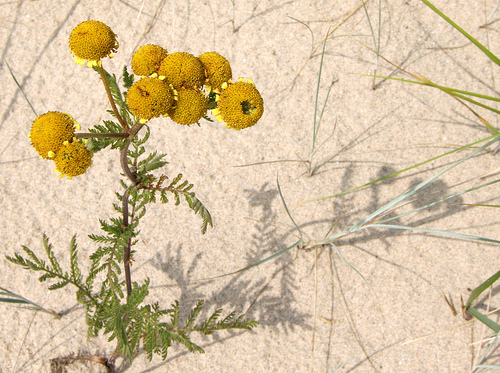
Huron tansy, Tanacetum huronense
(*photo
credit)
November 25, 2007 Christ's Cross: Weapon of Mass Blessing
It pleased God to make absolute fullness reside in him and, by
means of him, to reconcile everything in his person, everything I
say, both on Earth and in the Heavens, making peace through the
blood of his cross. (Col. l:19-20)
Again we celebrate the feast of Christ the King and wonder
what more can we said (check past reflections -- 11/21/04;
11/20/05; 11/26/06). In the three-year cycle we focus this year on
the cross of ignominy and glory, or curse now transformed into
blessing. The contrast makes us view a world threatened by mass
destruction and see here in the grace of Christ an opportunity to
bring about blessing to this troubled world. Mass destruction or
mass blessing: which way will we turn?
Transforming weapons. What is now becoming clear to us is
that the threat of a weapon, whether the cross in ancient times or
the weapons of mass destruction (WMD) today, does not change
conduct for the better; it generally leads to more violence and
destruction. The threat of weapons leads to doom. The
transforming of weapons into instruments of usefulness and benefit
includes beating spears into pruning hooks and swords into
plowshares. What was invented for being death-dealing can be
transformed into something life-giving.
Reminders. Rudyard Kipling wrote of the somewhat transitory
glory of the British Empire ...
The tumult and the shouting dies,
the captains and the kings depart,
Still stands the ancient sacrifice,
the humble and the contrite heart.
Lord God of hosts be with us yet
Lest we forget, lest we forget.
A century ago royalty ruled the great majority of the world's
people from India to Russia, from China to Germany. Today royalty
is part of a constitutionally restricted government for less than
one-tenth of the world's people. Lest we forget, there is only one
king now who rules over all and that is Christ himself. A royalty
based on high status through nobility of birth has now given way to
one person, begotten and author of life, Jesus Christ.
Transforming kingship. Through the sacrifice of Jesus Christ,
the ghastly weaponry of a cross has been transformed into a badge
of glory; the glitter of kingship has been replaced by a humble
leader stripped and scorned who does it all out of love for us.
Through him weapons can be turned into beneficial means of
salvation and royalty can be shared by all who are baptized. The
transforming action is not sudden but it is occurring over time.
What is not being recognized is that this transformation includes
shared citizen action on our part. On this feast of Christ the
King we must make our world less dependent on weaponry and make it
more democratic in leadership and participatory practice.
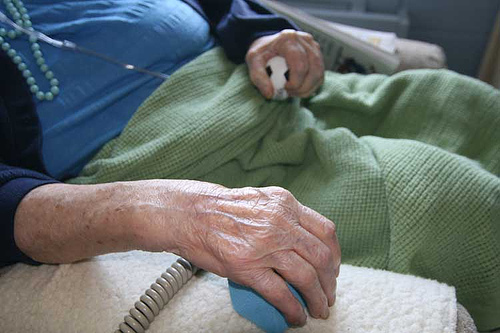
My Grandma (Janet Powell), sitting in a lift chair in her nursing
home
(*photo
credit)
November 26, 2007 Shut-Ins As Earthhealers
The resource is there. In the post-Thanksgiving week we
sometimes think about shut-ins who are preparing to endure the
coming grayness of the winter season. We sympathize with those who
cannot get out and travel as much as they used when ambulatory or
with a car license. As mentioned in an earlier reflection
(10/28/04), the cheerful shut-ins are an inspiration to many, and
their sacrifices are part of saving this troubled world. Let us
move beyond sympathy to an attitude of positive encouragement:
each person who is restricted by physical weakness or health
problems can offer the sufferings he or she endures in union with
the suffering Jesus for others. Many are inspired to pray for a
particular wayward acquaintance and this is laudatory; they can
also extend the vision to the entire world and to this troubled
planet.
Bring Good News. Let us look on the so-called "incapacitated"
multitude as "people resource," as an immense spiritual source of
energy that is capable of being tapped for the benefit of many.
We become the bearers of Good News when we carry the message of
their spiritual potential actions to them. The Spirit can inspire
us to say this message in different ways: as a current activity
that gives meaning to suffering; as a future investment in a
heavenly home; as a way to make up for the waywardness of our past
lives. Another approach is to show that a generous offering of
one's sufferings can have immense benefit not as individual
investment or satisfaction but as an apostolic means of helping
others. Let us consider the "Little Way" of St. Therese, the
Little Flower (who was a shut-in who gave all in love of God and is
now the patroness of the foreign missions).
Shut-in as healer. A third is a more pragmatic approach: if
you offer this day to the Lord for those who could be inspired to
touch this website, you will help Spread the Word in your own way
right from your home base. We speak of those who can stop
pollution practices, conserve resources, get people to use
renewable energy, and buy and use more efficient vehicles. What
the shut-in as healer can do is encourage others to reflect on the
power that is present in their own cheerful act of offering. They
can become a healer by inspiring other through their sacrifices to
read this reflection and find meaning therein.
Anticipation of a group. By 2008 we hope to develop a titled
group who will act as an auxiliary association with this website.
We will settle on a name for the group of people who will be formal
healers, those who are on a par with physicians and medical
specialists. These are to focus not on being healed but on the act
of apostolic healing; therein their own ministry will become part
of the world's healing just as much as that of a worker in a
hospital, a nursing home, or a medical laboratory. The shut-ins
can suddenly come to see the goodness of God empowering them to
enter more fully into the Calvary event. Thus they are a valuable
part of a world network of those seeking to be active Earthhealers.
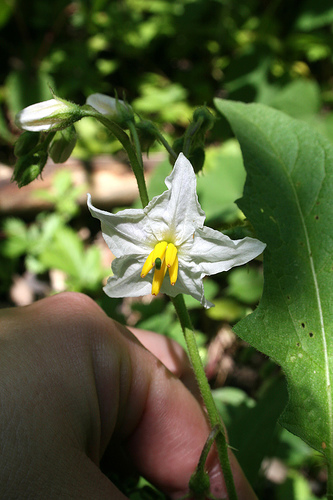
Carolina horsenettle, Solanum carolinense
(*photo
credit)
November 27, 2007 Sauerkraut or Choucroute
Cette spécialité servie à travers toute l'Alsace....
-- L'Alsace: Province de Caractère
We think of sauerkraut as German or Alsatian (French),
although the Chinese may have been first. However, Americans
modify good things, and kraut can be garnished with juniper berries
(Alsatian) and caraway seeds (more American)? Whatever the
origins, we Americans stake our claim to sauerkraut to some degree.
Kraut-makin' was an important event in early summer when the
cabbage was ready and we got out the kraut cutter, a board with
sharp knives for shaving the cabbage head. We kids would wash our
bare feet and vie to tromp the kraut in the receiving container;
we would climb inside a large ten-gallon crock and dance about
pressing the layers of freshly produced kraut and salt (the "sauer"
ingredient for preservation and taste). I think it was the only
farm chore my older sister Dorothy ever enjoyed doing. However,
the pressing was not the end of the operation. My mother had the
added work of doing the cooking; in later years, when the number of
mouths grew smaller, she canned the kraut in gallon jars and did
not have to maintain the heavy crocks. The quantity indicates what
a major role saurkraut played in our farm life.
Why kraut in November? That was the month the fermentation
was sufficient to allow us to eat the product. Really it was
because one major farm event that I have as yet refrained from
mentioning occurred in that month -- hog killing. The butchering
of these animals was a very important event in our farm life and
yet it was hard work and too filled with squeals to dwell on. The
combination of sauerkraut and the fresh pork made for the special
gastronomic experience. In fact, the Alsatian hardly conceives of
this dish without associated varieties of pork, and La Grande
Choucroute contains seven types of pork and a touch of Alsatian
wine. Our recent vegetarian tendencies take something away but
permits creative good flavored substitutes.
Sauerkraut and the Appalachia. In the 1970s, being from
Kentucky, I was asked by the Appalachian Pastoral Letter Committee
(This Land is Home to Me) to approach Bishop Ackerman of Covington,
a quite conservative bishop, for his approval of the document. The
committee reckoned correctly that his signature was crucial to its
success. Joe Holland, the writer, and I had lunch with the good
bishop and we entered into a conversation that mostly focused on
the qualities, preparation, cooking and tastes of good sauerkraut.
Time was taken up and after more pleasantries we concluded the meal
and wondered whether Bishop Ackerman would approve the statement
since we neglected to discuss the letter's contents as such. In
due time the Bishop told the committee that he had a good
discussion with us and he readily signed the letter -- a most
liberal contribution to the social justice literature. Sauerkraut
be blessed! Even this humble but noble dish has a part to play in
healing our Earth.
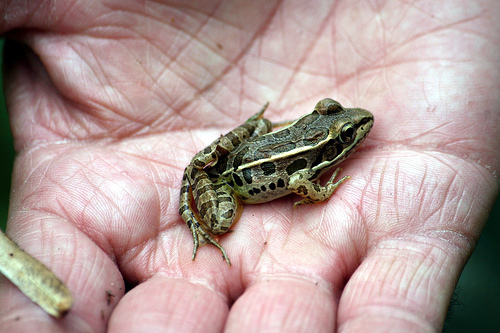
Southern Leopard Frog, Rana sphenocephala
(*photo
credit)
November 28, 2007 Credit and Borrowing from Future Generations
After I have spoken against living on credit cards and the
fast credit mentality in various Reflections and after we have all
endured the recent credit crunch, some may say -- "Don't tell me I
told you so." I promise I won't, even though it is a temptation.
I must confess to praying that our world would learn a lesson, for
it needs one very much. The motivation of these prayers needs to
be explained, for financial lessons are far less painful than
physical suffering from bloody revolution.
Granted, some may have to borrow to make ends meet, to build
a home, to start a business, to buy a car, or to pay off a major
bill. Borrowing without an assured way to repay on time or with no
intention of paying back during one's lifetime is bad, very, very
bad. Borrowing on supposed inflated home values also fits that
wrong-headed category. These practices amount to a form of
substance abuse for they abuse money that is meant to further a
fair exchange of goods and services. The rotten system of
borrowing on easy credit is a shared fault of both lender and
borrower -- and the worst thing to do is to hope that supposedly
rich Uncle Sam will bail out one or other negligent party. To
allow such easy credit is a fault of our total economic structure,
and corrections with belt-tightening may need to occur.
Excessive borrowing allowed a consuming public to buy bigger
houses, more inefficient cars, more powerful motor boats and a host
of energy-gobbling devices all at the expense of the finite store
of lower-priced non-renewable oil and gas resources. And these
excessive habits have resulted in current air and water pollution
and global warming problems. We would not have consumed so much if
the fad of borrowing against a supposed inflated value of a home
were not encouraged -- and if so much pretending were not
considered normal. Eventually "the chickens came home to roost."
As mortgage fine print schedules have kicked in and payments due
have picked up in amount, one can expect more impending
foreclosures. And is any one individual to blame or are these the
results of rotten policy?
A permissive system that allows such borrowing beyond the
means of reasonable repayment is unrealistic. It is burdening
future generations with enormous debts long after the spender has
died. With one trillion dollars owed to China alone, we as a
people need to come to its senses. This is a time of sober
reassessment, for we are all too deeply marred in the credit
culture. Certainly, tightening credit may patch a faulty system.
Probably the liquidation of all debts is a fresh but revolutionary
start. Are there any painless major readjustment gimmicks? Will
massive unemployment follow before consumer spending reaches
reasonable levels? Will we learn a lesson or will the indebted
seek to beat this lenient system one more time before these
borrowers exit this mortal life? Yes, credit triggers many
unanswered questions. Let's put credit into the hands of those who
live within their means. Maybe they have answers.
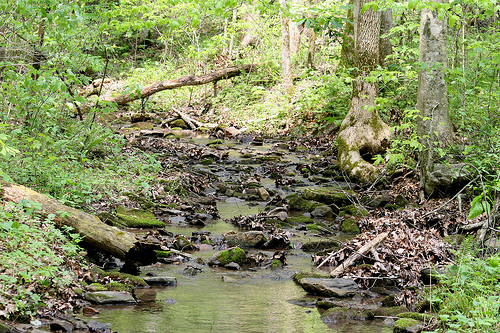
Streamside along Greenleaf trail, Cumberland Gap National Historical
Park
(*photo
credit)
November 29, 2007 Self-Denial and Advent
As we approach the season of Advent, we should think ahead
about what we ought to do. We Americans have many issues to face
in the coming months, and resource conservation is one for it must
accompany the move to a carbon-free and nuclear-free economy. Our
record on resource conservation is spotty for we are not a people
who regard self-denial as a virtue. In fact, it is regarded by
many as unpatriotic for it is counter to the consumer spending
culture in which we live and supposedly thrive. However, lack of
self-denial could be the death of us all -- and the upcoming
holiday season, which is really launched in earnest this week, is
the epitome of this self-indulgent practice. It involves giving
every loved one and remote associate something that is of proper
expense to show concern and willingness to spend.
Lack of will power. Let us squarely face this inherent
weakness of our culture. We are unable to discover a willingness
to say "no" to certain practices and things. And this lack of
willingness to deny ourselves extends from individuals to families
and to the nation as a whole. We are in critical need of better
practices as individuals and better governance as a nation. We
like to find fault with impoverished or decadent governments in
other places, but never pause to see that our governance has much
that needs improving. In fact, this is the first time in American
warfare history that citizens are not required to ration or
practice self-denial in any way. This current American
administration has sent a mixed message: it says that we are
addicted to oil; and it says to keep the economy afloat by spending
more. This is not the way to handle addicts; you do not encourage
them to consume more drugs or alcohol. Instead, you seek to
establish ways to lower temptations and raise the willingness to
avoid the addicted product or, better yet, go cold turkey.
And what about churches? I refrain from being critical of
most church groups and practices. However churches are the ideal
place to preach self-denial. We preachers do not like to say the
unpopular lest the congregation abandon us. Therefore in the
tradition of the false prophets of old we search for only syrupy
and nice things to make all feel comfortable about their self-
indulgence. Self denial is never a part of the agenda lest the
money stop flowing into the coffers. And instead, the church
messengers would rather indulge themselves in saying how to do some
very little things such as a weekend volunteer foray -- which is
not bad in itself. It is just not self-denying.
Towards meaningful self-denial. The need for enhancement of
willpower is so utterly necessary that it should be the number one
item as we approach the holiday season. We have to give up our
excessive consumption so that others will have enough. Saved money
that could be spent for luxuries could go for food, medicine or
even education for a distant hungry, sick or destitute youth.
Many such saving programs exist but to make a special one your own
will help the process of self-denial along.
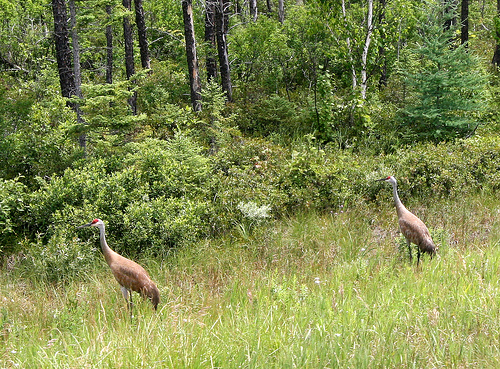
Sandhill Cranes, Grus canadensis
(*photo
credit)
November 30, 2007 Share the World's Resources
Each month we like to highlight a non-profit group or series
of organizations that is trying to heal our troubled Earth in some
fashion. We are featuring this month those groups who are seeking
to share resources among all people. This is especially important
because we will not be able to have an integral and healthy world
unless those with much share with those lacking the basics of life.
One group, "Share the World's Resources (STWR), recognizes
that "poverty causes the needless deaths of 50,000 people each day,
and international aid continues to fail the poorest countries." It
adds that basic needs are not being secured for the majority of the
world's poor, that climate change will affect the poorest, and that
inequality within and between nations is continually widening as a
direct consequence of free market policies. STWR believes that
sharing is a natural law of economy, a simple process that when
implemented on a global scale can transform the way resources are
distributed. Granted, this has not been tried on a global scale
with the exception of the Marshall Plan after World War II.
Basic agricultural produce, clean water, vital medicine, land,
energy and the atmosphere are amongst the resources, which, if co-
managed by the international community, can secure basic human
rights across the world. Resources can only be shared effectively
if they are cooperatively owned by the global public rather than
corporations or individual countries. Without this affirmation of
international unity, confrontation between nations over resources
will inevitably continue. Enough food, water and medicine are
available for every person on the planet. If the international
community is committed to creating a sustainable world without
poverty, we must act now to reorganize the economic system in line
with the principles of cooperation and sharing.
STWR believes that a new United Nations agency can hold these
basic resources in trust on behalf of the global public and
initiate an emergency redistribution program to tackle extreme
poverty. A system of sharing would result in a smaller free market
economy and thereby reduce the activity and influence of market
forces and multinational corporations...Wealthy nations will have
to consume less, reduce carbon dioxide emissions , and redistribute
surplus resources to where they are most urgently needed. Sharing
resources directly with local communities can also create rapid
bottom-up development and eliminate the need for international aid.
STWR seeks to be an informational and networking organization
and invites all to make themselves known to the group on --
<www.stwr.net>
STWR
PO Box 52662
London N7 8UX
United Kingdom
|